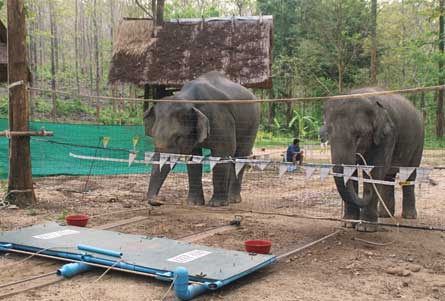In a test of cooperation, elephants know when two trunks are better than one.

Working in pairs, elephants learned to pull on the same rope at the same time to haul tasty corn within reach, says comparative psychologist Joshua Plotnik, now at the University of Cambridge in England. The animals didn’t just learn a trick by rote, he says, but rather showed signs of grasping the basics of how cooperation works.
For example, elephants alone at the snack site learned not to pull at the rope or leave before their partners arrived up to 45 seconds later to help with the task, Plotnik and his colleagues report online March 7 in the Proceedings of the National Academy of Sciences. “That’s a long time for an animal waiting for food,” he says.
And elephants weren’t just learning that they needed a buddy beside them, Plotnik says. When researchers positioned one end of the rope so the partner pachyderm could arrive but was unable to do any useful pulling, the first elephant sometimes gave up the hopeless task and turned away, even when the partner was still in place.
Plenty of cooperative ventures in the animal kingdom could be explained as partners just following rules without understanding the interaction, Plotnik says. So pull-together tests, originally designed for primates, have become a way to probe how animals’ minds work.
In the cooperation tests, elephants “are on par with chimps,” Plotnik says. Evidence that animals other than primates can pass a pull-together test is skimpy so far. Hyenas learned they needed a partner in a test version designed for them. Rooks, renowned as clever birds, learned to cooperate but not to wait 45 seconds for a partner. “Birds are extremely cooperative, but aren’t necessarily very patient,” Plotnik says.
But scientists don’t yet know what other animals can do, says primatologist Elisabetta Visalberghi of the Institute of Cognitive Sciences and Technologies in Rome. “The importance of this article is that once again it demonstrates how uniqueness can be a by-product of ignorance.”
Savvy animals still remain to be tested, adds Diana Reiss of Hunter College in New York City. “Dolphins would be excellent candidates to test,” she says. They can recognize themselves in mirrors and show considerable cooperation in rearing young, searching for food or, in some cases, searching for mates.
To design a test appropriate for elephants, Plotnik worked with study coauthor Frans de Waal of Emory University in Atlanta to modify a test used for primates. The researchers outfitted an elephant-sized platform with two bowls of food treats mounted on the front edge. Threaded around the table was a single rope with its ends dangling into lanes where elephants showed up for a snack. One important feature, Plotnik says, was that if one elephant pulled on the rope before the partner got a grip, the rope would jerk out of the partner’s reach so no snacks would be available during that particular round of testing.
Six test elephants, each paired with a buddy, at the Thai Elephant Conservation Center in Lampang quickly learned that whether they were led simultaneously or somewhat out of sync to the rope ends, pulling together meant corn. On its own, that’s “great to see, but not all that exciting in terms of its interpretation,” Plotnik says. Only when the researchers complicated the task by delaying one elephant longer than 25 seconds or coiling one end of the rope out of reach did the researchers get a glimpse of what elephants understood about the task.
Understanding elephant cognition has special urgency these days, Plotnik says. He also serves as head of research for the Golden Triangle Asian Elephant Foundation in Chiang Rai, Thailand, and hopes that better understanding the animals will lead to new strategies for reducing conflicts between elephants and expanding human populations nearby.






